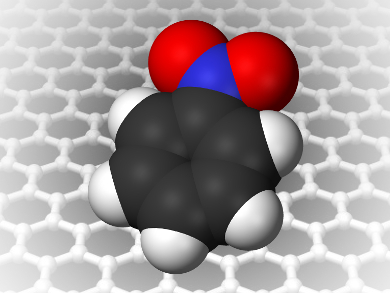Many pesticides, explosives, and organic dyes are based on nitroaromatic compounds (NACs). NACs are strongly attracted to the surface of graphene particles which make them suitable for absorbers. Graphene can be modified chemically to alter its electronic properties, and this offers a potential basis for detecting, sequestering, or chemically altering NACs.
Baoliang Chen, Zhejiang Provincial Key Laboratory of Organic Pollution Process and Control, Hangzhou, China, compared the adsorption of m-dinitrobenzene, nitrobenzene, and p-nitrotoluene onto the surfaces of graphene, graphene oxide, and reduced graphene oxide. They found that reduced graphene oxide had the strongest adsorption capacity, and graphene oxide the weakest. The most strongly adsorbed NAC was m-dinitrobenzene, and p-dinitrotoluene showed the weakest adsorption.
The team suggests that the adsorption of NAC molecules on graphene-based substrates involves interactions between the π-electron-deficient phenyls of NACs and the π-electron-rich matrix of graphene, as well as electrostatic interactions between the nitro groups and defects in the graphene sheets. According to the researchers, this proposed mechanism warrants further study.
- Macroscopic and Spectroscopic Investigations of the Adsorption of Nitroaromatic Compounds on Graphene Oxide, Reduced Graphene Oxide, and Graphene Nanosheets,
Xiaoxiao Chen, Baoliang Chen,
Environ. Sci. Technol. 2015.
DOI: 10.1021/es5054946




